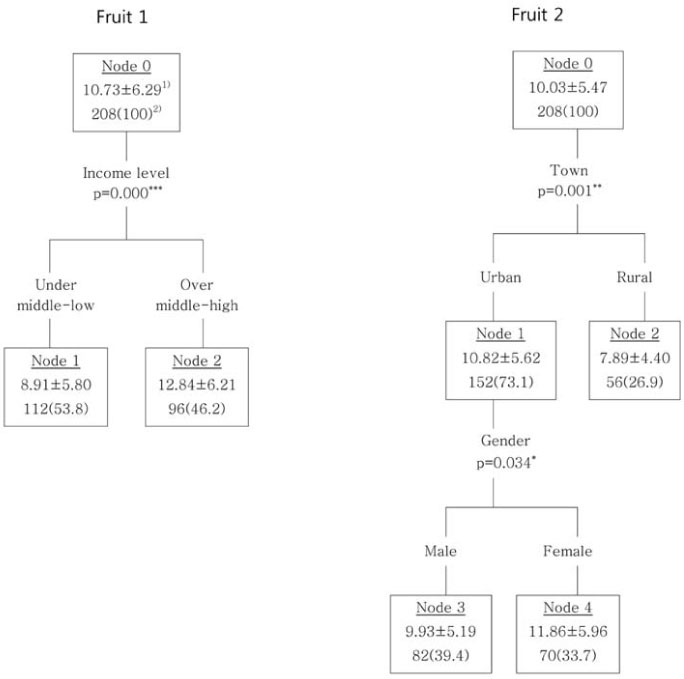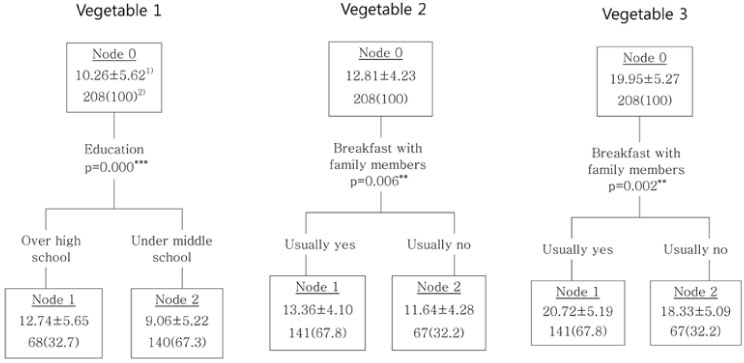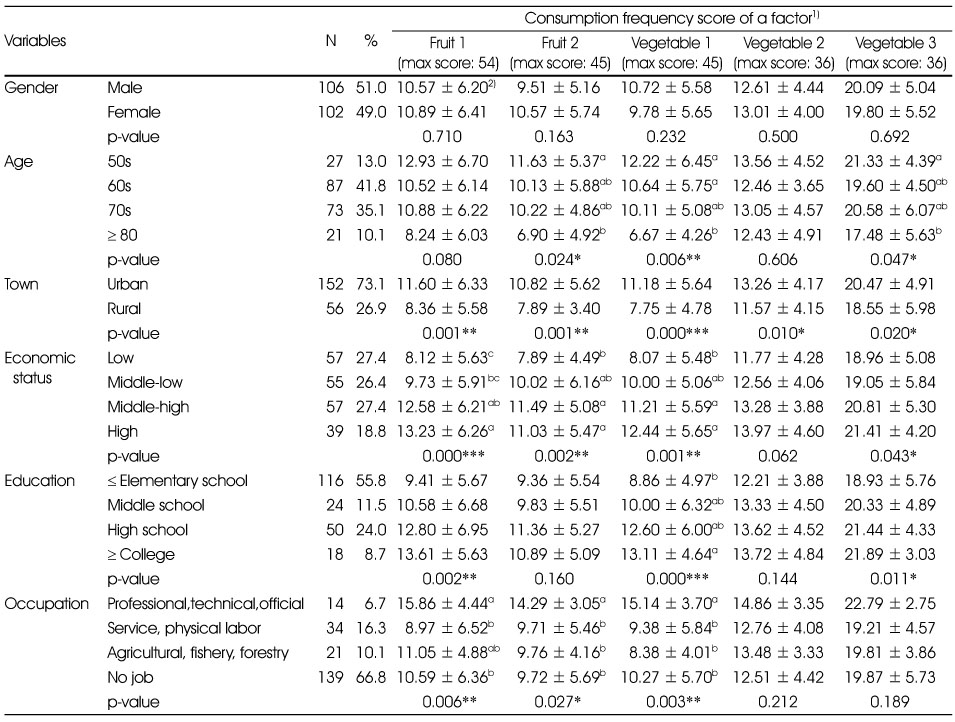Articles
- Page Path
- HOME > Korean J Community Nutr > Volume 19(5); 2014 > Article
-
Research Article
- Factors Associated with Fruit and Vegetable Consumption of Subjects Having a History of Stroke: Using 5th Korea National Health and Nutrition Examination Survey (2010, 2011)
- Sung Je Kim, Mi-Kyung Choi
-
Korean Journal of Community Nutrition 2014;19(5):468-478.
DOI: https://doi.org/10.5720/kjcn.2014.19.5.468
Published online: October 31, 2014
1)Department of Neurology, CHA Gumi Medical Center, CHA University, Gumi, Korea.
2)Department of Food and Nutrition, Keimyung University, Daegu, Korea.
- Corresponding author: Mi-Kyung Choi. Department of Food and Nutrition, Keimyung University, 1095, Dalgubeol-daero, Daegu 704-701, Korea. Tel: (053) 580-5872, Fax: (053) 580-5885, mkchoi@kmu.ac.kr
Copyright © 2014 The Korean Society of Community Nutrition
This is an Open-Access article distributed under the terms of the Creative Commons Attribution Non-Commercial License (http://creativecommons.org/licenses/by-nc/3.0/) which permits unrestricted non-commercial use, distribution, and reproduction in any medium, provided the original work is properly cited.
- 1,251 Views
- 8 Download
- 5 Crossref
Figure & Data
REFERENCES
Citations

- Classification tree analysis for an intersectionality-informed identification of population groups with non-daily vegetable intake
Emily Mena, Gabriele Bolte, Christine Holmberg, Philipp Jaehn, Sibille Merz, Alexander Rommel, Anke-Christine Saß, Kathleen Pöge, Sarah Strasser, Gabriele Bolte, Emily Mena
BMC Public Health.2021;[Epub] CrossRef - Functional and nutraceutical properties of pumpkin – a review
Simran Kaur, Anil Panghal, M.K. Garg, Sandeep Mann, Sunil K. Khatkar, Poorva Sharma, Navnidhi Chhikara
Nutrition & Food Science.2019; 50(2): 384. CrossRef - Development of a Food Exchange Table and Food Pattern for Nutritionally Balanced Menu Planning
Yun Ahn, Ikhyun Yeo, Sangyun Lee, Kisun Nam
Korean Journal of Community Nutrition.2018; 23(5): 411. CrossRef - Factors affecting vegetable preference in adolescents: stages of change and social cognitive theory
Taejung Woo, Kyung-Hea Lee
Nutrition Research and Practice.2017; 11(4): 340. CrossRef - Association between Grapes Intake and Diabetic Retinopathy: Inhibitory Effect of Resveratol on Diabetic Retinopathy
Bo Young Lee, Donghyun Jee
Journal of the Korean Ophthalmological Society.2016; 57(2): 276. CrossRef
- Figure
- We recommend
- Related articles
-
- Self-reported weight change and diet quality in relation to metabolic syndrome among Korean cancer survivors: a cross-sectional study using the Korea National Health and Nutrition Examination Survey 2019–2021
- The dietary factors associated with sleep duration in postmenopausal middle-aged women: a cross-sectional study using 2019–2023 Korea National Health and Nutrition Examination Survey data
- Analysis of the relationship between sugar intake and cancer prevalence: a cross-sectional study using the 8th Korea National Health and Nutrition Examination Survey
- Trends in growth and nutritional status of Korean toddlers and preschoolers: a cross-sectional study using 2010–2021 Korea National Health and Nutrition Examination Survey data
- Comparative study on the health and dietary habits of Korean male and female adults before and after the coronavirus disease 2019 pandemic: utilizing data from the 8th Korea National Health and Nutrition Examination Survey (2019–2021)


Fig. 1
Fig. 2
Validity and reliability of fruit and vegetable consumption frequency measure
Fruit and vegetable consumption frequency by characteristics of the study subjects
1) The consumption frequency score of a factor is sum of the scores for each food (0: rarely eat, 1: 6~7 times/year, 2: 1 time/month, 3: 2~3 times/month, 4: 1 time/week, 5: 2~3 times/week, 6: 4~6 times/week, 7: 1 time/day, 8: 2 times/day, 9: 3 times/day) included in the factor (Fruit 1: seasonal fruits, orange, apple, strawberry, melon, pear, watermelon, Fruit 2: easily-accessible fruits, persimmon, tangerine, grape, peach, banana, Vegetable 1: Western-style vegetables, cabbage, mushrooms, carrot, tomato, spinach, Vegetable 2: Korean-style vegetables, bean sprout, radish leaves, pumpkin/squash, seaweed, Vegetable 3: preserved vegetables, Korean cabbage, radish, laver, cucumber).
2) Mean ± SD
abc: Values with Different superscripts in a column are significantly different by Scheffe's multiple range test (p < 0.05).
*: p < 0.05, **: p < 0.01, ***: p < 0.001
1) The consumption frequency score of a factor is sum of the scores for each food (0: rarely eat, 1: 6~7 times/year, 2: 1 time/month, 3: 2~3 times/month, 4: 1 time/week, 5: 2~3 times/week, 6: 4~6 times/week, 7: 1 time/day, 8: 2 times/day, 9: 3 times/day) included in the factor (Fruit 1: seasonal fruits, orange, apple, strawberry, melon, pear, watermelon, Fruit 2: easily-accessible fruits, persimmon, tangerine, grape, peach, banana, Vegetable 1: Western-style vegetables, cabbage, mushrooms, carrot, tomato, spinach, Vegetable 2: Korean-style vegetables, bean sprout, radish leaves, pumpkin/squash, seaweed, Vegetable 3: preserved vegetables, Korean cabbage, radish, laver, cucumber). 2) Mean ± SD abc: Values with Different superscripts in a column are significantly different by Scheffe's multiple range test (p < 0.05). *: p < 0.05, **: p < 0.01, ***: p < 0.001

 KSCN
KSCN




 Cite
Cite


